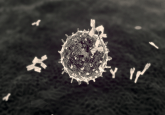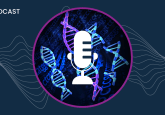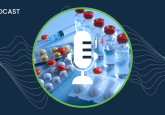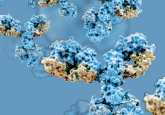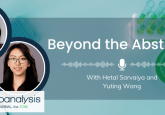Unveiling bioanalytical datasets for the successful development of ADCs
In this interview with Daniel Schulz-Jander (Senior Director, QPS Netherlands), we dive into the complexities of ADC bioanalysis, including how different techniques generate diverse datasets, the challenges of integrating data from ligand binding assays (LBA) and LC–MS/MS, and emerging bioanalytical strategies shaping the future of ADC development.
About the speaker:
 Daniel Schulz-Jander
Daniel Schulz-Jander
Senior Director, Bioanalysis (Mass spectrometry)
QPS Netherlands (Groningen, Netherlands)
Daniel received his Dipl Chem from the University of Kassel (Kassel, Germany) in chemistry, his Doctor rerum naturalium from the Technische Universität München (Munich, Germany) in environmental chemistry, followed by a post-doctoral fellowship in pesticide metabolism at UC Berkeley (CA, USA). Since then, Daniel’s scientific passion has been in bioanalysis. Starting in biotech at Ligand and Arena Pharmaceuticals (CA, USA), he then moved to Medtronic (CA, USA) where he built a bioanalytical team specializing in drug in tissue analyses. Since February 2022, Daniel is currently the Senior Director of bioanalysis mass spectrometry at QPS Netherlands, where his team supports small and large molecule bioanalysis with LC–MS/MS as well as ICP/MS.
Podcast transcript
[00:09] Emma Hall: Hello, and welcome to our podcast episode exploring bioanalytical datasets for the successful development of ADCs, sponsored by QPS. I’m your host, Emma Hall, and today I’m joined by Daniel Schulz-Jander, a Senior Director of Bioanalysis Mass Spectrometry at QPS Netherlands, where his team supports small and large molecule bioanalysis with LC–MS, as well as ICP–MS. Thank you very much for joining us, Daniel.
[00:39] Emma Hall: To kick us off, please could you introduce yourself and your role?
[00:43] Daniel Schulz-Jander: Yes. Thank you so much for giving me the opportunity to share my experiences and what we do at QPS. I’ve been with QPS about 3 years, leading teams that support, as you mentioned, bioanalysis for small and large molecules. What does that mean? We do rapid development, we do validations and then we do sample analysis for bodily fluids, as well as tissues for pre-clinical studies, and provide support for the development of, in this case, antibody drug conjugates (ADCs). But any large molecule or small molecule, we [also] analyze. We also do elemental analysis where we utilize ICP–MS.
[01:30] Emma Hall: In your World ADC London talk, you discussed unveiling the diverse and complex bioanalytical dataset needs for the successful development of ADCs. Could you explain a little bit more about what this involves?
[01:42] Daniel Schulz-Jander: Sure. So, ADCs are complex, and complex is a kind of undefined word of mystery. But in classical bioanalysis, we would analyze a small molecule, and determine the concentration and concentration time profile, and that will be the end of it. However, for ADCs, we are in a much more complex setup where we have a drug, [which] is called the payload in an ADC case, and then we have an antibody that targets the specific cells that are in need [of] being treated, so to speak. In this case, killed.
To induce apoptosis, the payload is attached to the ADC. This construct then has many parameters that can be determined to characterize this particular medicine. We typically determine the total antibody, where we look at the amount of antibodies that are floating in the bodily fluids. Then, we look at a slightly different parameter, which is called total ADC, so total ADC. So that is slightly different. That requires that the antibody still has the payload attached to it. We do that very specifically with our assets, and we’ll get into that a little later.
Then, we have the payload. The typical small molecule that is attached to the antibody, which has the purpose of targeting or triggering the apoptosis of the cancerous cells in most cases. These are the characterizations of the ADC itself, and a little bit more downstream on a ligand binding perspective. We also look at antibodies that are formed against the drug itself. These are so-called immunogenicity tests. These are very important in case the host system, maybe a pre-clinical model or a human patient, may raise antibodies against the ADC itself, and thereby reduce its efficacy and cause other biological interferences. This, we evaluate with immunogenicity tests. This is also in the early development [phase] because some particular epitopes may be more immunogenic than others.
We look at the characterization of these epitopes that trigger an immunogenic response. Then, we have also an aspect of how many payloads are attached to the antibody, which is called the DAR or drug to antibody ratio. This is a parameter that is typically reported as an average. But [during] development, it is actually very interesting and very critical to understand whether the antibody drug ratio changes over the PK profile and what kind of ratio one has. [This is] because the PK and the performance of that ADC may be very different depending on how many payloads are attached to the antibody. So, quite a few different assays need to be conducted in support of an antibody drug development program.
[05:17] Emma Hall: Amazing. Thank you so much. How do the types of bioanalytical data differ between the two techniques? Are there advantages of one over the other?
[05:27] Daniel Schulz-Jander: In the end, the technique should provide data, and they should be comparable. In general, the data is very comparable. However, there are some differences that [emerge] on the basis of how the assays are actually conducted and how we are measuring the device, [and] the ADCs. [A] ligand binding assay requires that the ADC is pulled down or separated from the matrix, and then we have a secondary antibody that needs to bind.
This is a biological antibody-antibody or motif epitope interaction, which in a bigger sense is not that specific. Meaning, very small modifications in the antibody actual sequence – your hydroxylation or some glycosylation – may not be recognized by the antibody because it recognizes a much larger motif. The selectivity of a ligand binding assay is less so specific than [an] immunoaffinity LC–MS assay, which looks for a very specific sequence.
If that sequence is no longer there because it gets metabolized or biologically modified due to conjugation or other chemical reactions, you will no longer see it with the mass spec[trometer]. One is more selective, and the other one is less selective. Depending on the ADC, that may or may not make a difference. Then the data is, as I mentioned, very similar. You may get lower detection limits with a ligand binding assay just because [of] the way these assays work and that might be of benefit. You [can] maybe get down to the lower picogram levels with a ligand binding versus a nanogram level for LC–MS. There are limitations on the assay itself.
So, the ligand binding assay really does not have any mass limitations. As long as the antibodies bind, you will be most likely successful [in] developing a ligand binding assay. However, [in terms of] mass spec, there are certain limitations just by the way our mass spectrometers are set up. But depending on how the assay runs, it needs to ionize, so you need to have some mass to charge ratio. This may be limiting the applicability of a mass spec assay.
From an operational perspective, another aspect that makes them different or more beneficial, [for] ligand binding, you can run plates probably a little faster than an immunoaffinity mass spectrometry assay, where you need to in typical cases, pull down the ADC, and at one point, the digestion step happens. Depending on the ADC and how good the digestion proteins work, that digestion can take quite some time. There’s a little less throughput on the mass spectrometry side.
The multiplexing, meaning multiple analytes measured at the same time, is very limited [for] ligand binding because the antibody recognizes certain motifs. Maybe one can have multiple secondary antibodies to differentiate, but that is very limited. [For] the mass spectrometer, it is really more [of a] question [of] how much time does one want to invest to do multiple analytes, or maybe, typically, we [measure] the ADC and the antibody together, or if one has the chance, they can also add the payloads to the assay. But that all depends on how the chromatography works.
There’s more multiplexing opportunity for the mass spectrometer. Another disadvantage on the mass spec [side] is [that] you need an internal standard, which is time[-consuming] and costly, and may not be available in the early phases when the program is still in the screening phases. A ligand binding assay does not require that. However, [a] ligand binding assay does require specific antibodies. So, there are pluses and minuses on both sides.
The ligand binding assay is a functional assay – you bind to a certain epitope of the ADC – whereas immunoprecipitation LC–MS is a surrogate assay because we digest the protein and then we have a shorter sequence. So, it’s only a fragment that we look at. We don’t look typically at the complete ADC. That can be done, but in a high throughput setting, [and] I have not seen a lot of applications for that.
The other aspect I mentioned initially [is] on the limited selectivity that the ligand binding assay has. So, in certain metabolites, ligand binding will not be able to distinguish, whereas on the mass spec side, we can look exactly for certain specific modifications due to the change in mass. That is another big opportunity for the mass spectrometer to provide additional insight in the development phase.
[11:01] Emma Hall: Thank you so much. It sounds very tricky to pick between the two techniques. When integrating LBA and LC–MS datasets, what key correlations or discrepancies do you commonly observe? Do you have any tips on reconciling these inconsistencies between the techniques?
[11:19] Daniel Schulz-Jander: I hinted to some of that, and that’s really driven by the question of the selectivity. What we observe in collaboration with our clients sometimes is that the PK data – so the exposure data that we get from the ADC – may not be reflective of what the clinical observations suggest. Meaning that there is still a pharmacological effect visible in the subjects or in the animals. However, we do not measure sufficient drug levels.
That goes back to the selectivity question that when small modifications happen on the ADC, [they] may not be functionally different. However, from a mass spectrometer [side], they are completely different. Meaning, if I add an oxygen to my fragment, the mass spectrometer will never look for it unless I tell it to do so. However, on the functional assay, [for] hydroxylation somewhere on the antibody, [it] may not really change the affinity to the target. There, we see these differences.
How do we resolve these? So, particularly at the site where I work at QPS in the Netherlands, we work very closely with our ligand binding team together, and we typically work with the ligand binding team to assess what can be done. We may do a cross validation and see if we can get better data transferring – perhaps a mass spectrometer assay to a ligand binding assay – and thereby resolve the high selectivity that the mass spectrometry assay showed by using a less specific assay, the ligand binding assay. Those are typical things that we see to address the problems.
Other things that we see [are] in the development phase. It may or may not be possible to get a really good secondary antibody that is specific to the payload for the ligand binding assay. Since the payload is a very small haptene, [and] most of them are not immunogenic, maybe the capturing antibody that should bind to the haptene or the payload itself may actually not be specific enough. In that case, we would then jump in from a mass spectrometry side, and look [at] whether a mass spectrometric assay would provide a good solution for that particular ADC. Then, the ligand binding assay may not be a suitable solution until a more specific secondary antibody is developed and can be utilized.
[14:14] Emma Hall: Amazing. Thank you so much, Daniel. What novel bioanalytical approaches are emerging to improve data set quality and depth for ADC characterization, and how do they compare to traditional LBA and LC–MS datasets?
[14:30] Daniel Schulz-Jander: [This] is a little [bit of a] tricky question. The high throughput testing hasn’t really changed a lot. From a characterization perspective, technology moves forward, and particularly on the mass spectrometry side, we get faster acquisition, higher mass ranges, more accuracy, and higher processing powers that help us with characterizing the ADCs. Moreover, instrument developers are also looking at different ways of fragmentation of the molecules that we introduce into the mass spectrometer.
Why is that an important question? Because in a mass spectrometer, you only measure the mass over charge ratio. To characterize it, you probably want to get a little bit more information than just a certain number. By fragmenting, you get smaller pieces of it. By changing the way you fragment your molecule, you can actually [deduce] very different structural information to characterize your ADC or molecule better.
One of the new technologies that has been developed [involves] an electron activation dissociation way of breaking molecules apart compared to the normal way that is used for all mass spectrometers, where you have a collision cell and the ions are being basically crushed against a certain gas, typically nitrogen, to break them apart. But here we have, similar to old GC Electron Capture Ionization (GC–MS), an activated electron that basically bombards the molecule. That’s what we find from the mass spectrometry side.
On the ligand binding side, [we get] better, more directive antibody raising and really understand that with more finesse of assays – a combined assay – [we can use] really targeted assays for [better] understanding [of] the immune response of the host body, maybe a rat or a mouse or dog, and then through computational sources [we can] model a better, less immunogenic ADC. Those are technologies that are up and coming and utilized with the start of various AI characterizations to really spearhead that and get better targets to have more efficient and successful ADCs.
[17:09] Emma Hall: Thank you so much, Daniel. Are there any new projects you can share with us that you’re excited for at QPS in the Netherlands?
[17:15] Daniel Schulz-Jander: Yes. My horizon is obviously focused on mass spectrometry. We expand and look into other modalities where the mass spectrometer is helpful. If it flies and hasn’t charged to mass to charge ratio, we will look for it, so to speak. Oligonucleotides have been in the news quite a bit, and so we work with our sponsors to support them with those kinds of assays. We look at multifunctional ADCs and bispecific antibodies to characterize those and monitor them with metric assays to get the support that they need.
We are expanding in larger molecules in a very distinct way and also providing helpful data to interpret unexpected metabolism modifications that a sponsor may see in one species over another or to help them characterize metabolism, which we are just getting into and we’re very excited about.
[18:24] Emma Hall: Amazing. Thank you so much. The expansion sounds very exciting, and it seems that you have a lot to look forward to.
Daniel Schulz-Jander: Indeed. Lots of busy times.
Emma Hall: Thank you very much for sharing your experience and insights with us, Daniel. It was a pleasure to speak with you today.
Daniel Schulz-Jander: Thank you so much for giving me the opportunity to share some of our experiences with you, and [I’m] looking forward to hearing the final product.
Disclaimer: The opinions expressed in this interview are those of the author and do not necessarily reflect the views of Bioanalysis Zone or Taylor & Francis Group.


